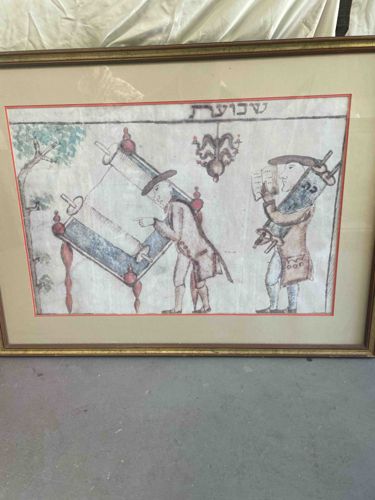
Framed Hand-Colored Jewish Folk Art Illustration of Scribes
This item is a framed, hand-colored illustration depicting two figures engaged in scholarly or religious activities, characteristic of Jewish folk art. The artwork is presented under glass with a light beige or off-white mat, encased in a simple, thin gold-toned wooden or composite frame. The central image is rectangular, bordered by a thin red line. At the top of the illustration, what appears to be Hebrew text is visible, reading 'שבועת' (Shavuot or Oath/Pledge), though only partially visible in the provided image. The left figure, wearing what resembles a 17th-18th century European style frock coat, breeches, and a distinctive tall hat, is leaning over a large scroll or open book supported by an ornate stand with red turned legs and finials. He appears to be writing or studying the text on the scroll, which has blue-grey sections. Above him hangs a chandelier-like fixture. To the right, another figure, similarly dressed but with a simpler hat, holds a smaller, open book or scroll and seems to be reading from it. Both figures have simplified, almost caricatured facial features typical of folk art. A stylized tree with light green foliage is visible in the upper left corner, suggesting an outdoor or natural element. The colors are muted pastels - light blue, red, brown, green, and a pale yellow-gray for the background paper, indicating watercolors or hand-tinted printing. The paper itself shows signs of age, with slight discoloration or foxing, contributing to its vintage appearance. The composition is two-dimensional, lacking deep perspective, a common trait in folk art. The craftsmanship is rudimentary but charming, focusing on narrative and symbolism over realism. There are no discernible artist signatures or specific maker's marks visible through the frame. Based on the style and subject matter, it likely dates from the early to mid-20th century as a rendition of traditional Jewish themes, although older origins cannot be entirely ruled out without further inspection out of the frame.
AI-Generated Appraisal Disclaimer
Estimated Value
$250-400
Basic Information
Category
Folk Art Print/Illustration
Appraised On
December 18, 2025
Estimated Value
$250-400
Item Description
This item is a framed, hand-colored illustration depicting two figures engaged in scholarly or religious activities, characteristic of Jewish folk art. The artwork is presented under glass with a light beige or off-white mat, encased in a simple, thin gold-toned wooden or composite frame. The central image is rectangular, bordered by a thin red line. At the top of the illustration, what appears to be Hebrew text is visible, reading 'שבועת' (Shavuot or Oath/Pledge), though only partially visible in the provided image. The left figure, wearing what resembles a 17th-18th century European style frock coat, breeches, and a distinctive tall hat, is leaning over a large scroll or open book supported by an ornate stand with red turned legs and finials. He appears to be writing or studying the text on the scroll, which has blue-grey sections. Above him hangs a chandelier-like fixture. To the right, another figure, similarly dressed but with a simpler hat, holds a smaller, open book or scroll and seems to be reading from it. Both figures have simplified, almost caricatured facial features typical of folk art. A stylized tree with light green foliage is visible in the upper left corner, suggesting an outdoor or natural element. The colors are muted pastels - light blue, red, brown, green, and a pale yellow-gray for the background paper, indicating watercolors or hand-tinted printing. The paper itself shows signs of age, with slight discoloration or foxing, contributing to its vintage appearance. The composition is two-dimensional, lacking deep perspective, a common trait in folk art. The craftsmanship is rudimentary but charming, focusing on narrative and symbolism over realism. There are no discernible artist signatures or specific maker's marks visible through the frame. Based on the style and subject matter, it likely dates from the early to mid-20th century as a rendition of traditional Jewish themes, although older origins cannot be entirely ruled out without further inspection out of the frame.
Get Your Items Appraised
Instant estimates of your treasures with AI-powered instant appraisals